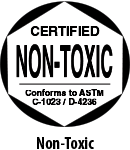
A water based unique formulation that is smooth and creamy – perfect for base coating, brushwork and dry brushing.
Softees® are highly pigmented acrylic paints that can be used on ceramic bisque, wood, fabric, plaster, paper, and metal.
Softees® are more concentrated (less water) than most conventional acrylic craft paints, so it takes fewer coats to get deep, opaque, rich color. Opaque coverage can be achieved in one coat; two thin coats are recommended.
Shake well to thoroughly mix the contents. Apply to ceramic bisque or craft surface of choice. If using on bisque, lightly wipe the bisque surface with a damp sponge to remove dust or dirt. Use a synthetic brush for basic application: a base coat brush or a soft hair paint brush is ideal. Apply two thin coats for best results. Allow to dry thoroughly. Clean brushes in warm water and Brush Cleaner. While Softees® are self-sealing you may want to use a sealer to provide extra protection for the decorated surface from dirt, oils from handling, etc.


Softees® Acrylics are certified as Non-Toxic, safe for use by artists of all ages when used according to manufacturer’s directions. For ornamental use only.
Dry brushing is a technique where very lightly loaded brushstrokes are used to tint a piece in gradual layers. A stiff synthetic brush is best for this technique.
Loading the Brush: work the brush into the color, and then wipe the excess color onto a paper towel until the bristles feel almost dry. Work the brush back and forth several times on the paper towel until little color remains in the brush.
The brush is worked in a soft back and forth motion until an evenly blended coat of color is achieved. In dry brushing, the color is slowly deposited, building up in layers. Some people describe this motion as “tickling,” “dusting” or “dancing” the color onto the surface. A heavier pressure of the brush will distribute more color onto the ware. A gradual building up of color is the desired effect. As you paint, the brush may or may not be cleaned in between colors to give a better mixture of colors. If the brush is cleaned between colors, all moisture should be removed by squeezing the brush in a paper towel before again loading the brush with color. It is better to let the brush dry completely, as the added moisture from the brush will affect the dry brushing technique. Allowing a couple of minutes of drying time to pass before the next color is applied works best. Working too fast between color applications can cause the previous color to be lifted off the piece. The general technique for dry brushing can vary depending upon the base coat color that is applied to the piece. Some techniques call for a dark color, such as black or dark brown, to be applied first to the entire surface of the ware. Then dry brushing of various colors in sequence is done to achieve the final effect. Other techniques call for you to apply a dark hue and then slowly apply lighter shades of that hue. Either technique is acceptable as long as the desired effect is ultimately achieved.
Yes and no. No, if the brushes are properly and thoroughly cleaned. However, it is recommended to keep glaze and acrylic brushes separate.
Yes, Softees are intermixable as well as adding black to shade a color or white to tint a color.
No. You many want to apply AC-501 Gloss Brush on Sealer or AC-502 Matte Brush on sealer to provide extra protection for the decorated surface. Q: Do I need to seal the Pearls acrylics? A: No, it is self sealing. Q: What is the difference between White Metallic Pearl and White Iridescent Pearl? A: White Metallic Pearl is just as the name describes, white with a pearl effect. White Iridescent Pearl adds an iridescent color spectrum lick a prism when it casts greens, blues and other colors.
No, since it is not a fired product. It is mainly for decorative surfaces and not recommended for dinnerware.
Yes, you can make any Softees® color have a pearlized effect.